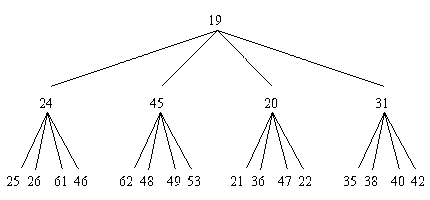-
Answer the sample questions for exams 1, 2, and 3.
-
Answer the questions on exams 1, 2, and 3.
-
Carefully define/explain the following:
| Hash Function |
|
|
| Binary Search Tree |
|
|
| 3-Heap |
|
|
| Collision |
|
|
| Complete Graph |
|
|
-
Indicate whether each of the following statements is true or false:
| (1) |
_____ |
Collisions improves the performance of a hashmap.
|
| (2) |
_____ |
Every node in a 3-heap has exactly three parents.
|
| (3) |
_____ |
The merge sort algorithm always outperforms the selection
sort algorithm.
|
-
What is for the algorithm (we discussed in lecture)
for inserting a node into a binary search tree? Use
notation.
-
Discuss the advantages of chaining over probing (for collision resolution).
-
Using the following hash function:
int hash(int key)
{
int result;
result = key % 2;
return result;
}
insert the following keys:
5
4
2
1
3
7
8
into a chained hashmap. Show all of your work for each insertion.
-
Is the
hash() function in the previous question:
-
Perfect? Why or why not?
-
A good hash function to use for a hashmap? Why or why not?
-
Complete the following function (that might be used, for example,
in a mid-square hash function). Note: You should not concern yourself
with leading zeroes.
/**
* Returns the middle digits of a number
*
* @param number The number
* @param numDigits The number of digits in the return value
*
* @return An int containing the middle digits
*/
int middleDigits(int number, int numDigits)
{
int middle;
return middle;
}
-
Write a function that would be appropriate for hashing a set of JMU course
identifiers (e.g., CS139, CS239, ENG152).
-
Construct a binary tree that represents all of the possible outcome of
tossing a coin three times.
-
Draw all possible binary search trees containing the four elements
1, 2, 3, 4.
-
Insert the numbers 49, 28, 66, 13, 35, 62, 80 (in order) into a
binary search tree. Show all of your work. Discuss the properties
of this BST.
Now insert the numbers 13, 28, 35, 49, 62, 66, 80 (in order) into a
binary search tree. Show all of your work. Discuss the properties
of this BST.
-
Write a function that finds the next-largest item in a subtree of a
linked binary search tree. How would your answer change if the
binary search tree is stored in a contiguous data structure?
-
Write a function that finds the height of a linked tree (with an
arbitrary number of children).
-
Insert the numbers 9, 8, 4, 6, 2, 3 (in order) into a 2-heap using a
linked data structure. Show all of your work.
-
Insert the numbers 9, 8, 4, 6, 2, 3, 1, 5, 7 (in order) into a 3-heap using a
contiguous data structure. Show all of your work. (Make sure you describe
the functions/algorithms you used to determine the indexes of
parent and child nodes.)
-
Given the following illustration of a 4-heap:

-
Change the 62 to a 49 and perform a "sift up".
-
Change the 46 to a 17 and perform a "sift up".
-
Remove the smallest element by swapping the "front" and "back"
elements, removing the new "back" element, and performing a sift down.
-
Add a new element (with a value of 27) by making it the "back" element
and performing a sift up.
-
Given the following illustration of a directed graph (where the
numbers next to an edge/link represent its "length"):

calculate the "shortest" path from vertex/node 0 to vertex/node 8
using the label setting algorithm discussed in lecture. Show your
work in the tables next to each vertex/node (i.e., each time you
change the label associated with a vertex/node you must add a row
to the associated table that contains the new label and the new
predecessor).


